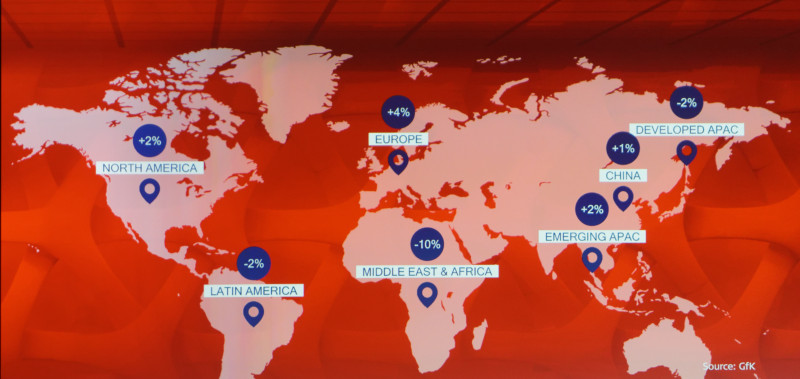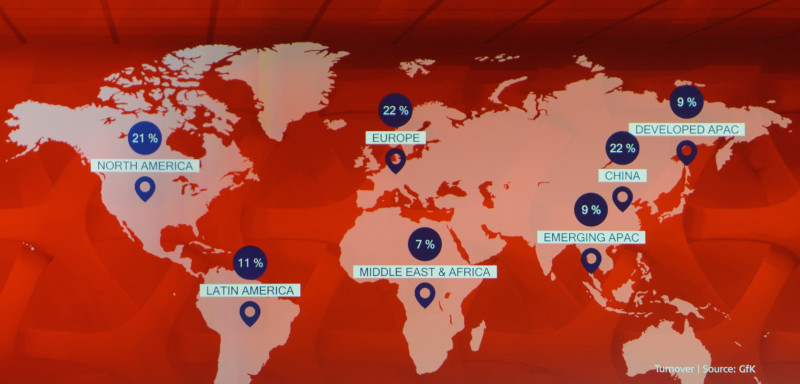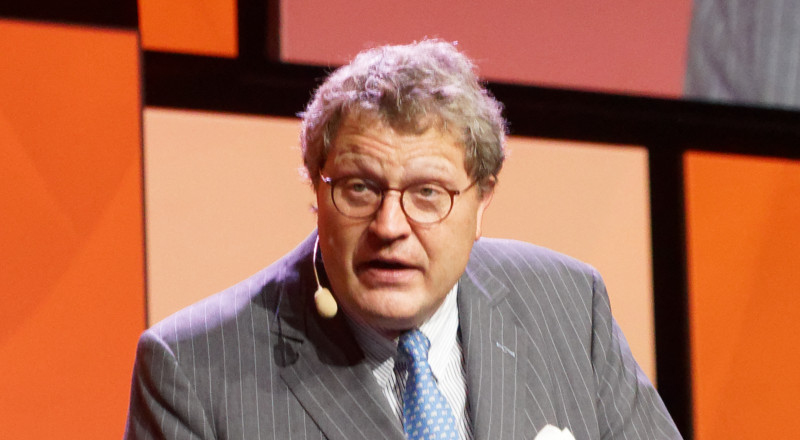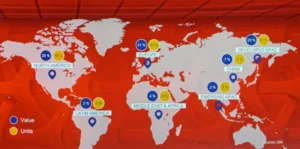The second event we went to during the press days was the IFA Global Opening event which took place in the “IFA Next” area. where conferences and discussions are held and where research and start-ups can present.
IFA sold out record floor space to more exhibitors than ever before, and more new product launches. This year, the IFA Next area has doubled and this year, the area has added Shift Automotive, developed with the Geneva Motor Show.
The speakers followed the ‘same procedure as every year’.
GfU Chairman, Hans-Joachim Kamp, opened by saying that the partnership between GfU and Messe Berlin has been extended for an additional five years.
 Kamp covered TV market developments. Image:Meko
Kamp covered TV market developments. Image:Meko
Turning to the consumer electronics market, the first six months of the year saw 1% growth at €374 billion. China, Europe and the US, combined, represent almost 70% of the global CE market. Europe is leading in growth, and both North America and China are both up but other regions are down.
 Growth in the TV market is variable around the world. Image:Meko
Growth in the TV market is variable around the world. Image:Meko
TV sales are up in value and volume. From a geographic share perspective, Europe & China each have around 22% and North America represents 21% of the global market. Latin America and APAC are both growing, but MEA is very weak at the moment.
The market is expected to hit a volume of 238 million units with a value of €107 billion.
 The markets in China and Europe for TV are bigger than North America. Image:Meko
The markets in China and Europe for TV are bigger than North America. Image:Meko
Kamp then looked at features. UHD set sales are strong in the most developed areas and in China. China is high on volume share, but lower on value. OLEDs are especially strong in Europe and if you combine the region with ‘developed APAC’ and North America, those three regions account for 84% of total global sales.
Europe is very important for OLED sales with over 40% of the world demand. Image:Meko
Smartphone sales will be flat this year and are expected to reach 1.46 billion units. China has 47% share in unit terms. Emerging Asia is showing growth of 8% in volume. Audio and headphone categories are growing.
Wearables are growing and are forecast to reach 169 million devices in 2018 and in the first half sales were up 6%, with 5% growth forecast for the second half.
Voice control and AI are dominant trends this year. Both are developing fast and generating innovations in consumer electronics.
Household Appliances Celebrate 10 years at IFA
Dr Rheinhardt Zinkan, in his wonderful British English accent, looked at household goods, which have been at IFA for ten years now.
 Zinkan said that small appliances are getting communications (I saw a Bluetooth iron!) Image:Meko
Zinkan said that small appliances are getting communications (I saw a Bluetooth iron!) Image:Meko
Global small domestic appliances are going well. There are many different product categories but the total volume is more than 500 million. Sales in Europe are ‘doing fine’, but with mixed results around the region. There are a number of growth categories and even communication technology has now come to the small appliances.
Looking at big appliances, the market is very variable, globally, and below the forecast from the early part of the year.
In large appliances, Europe was again very different by region and overall, the market declined in Europe in 1H 18.
Around the world, an increasing middle class helps the market growth and GfK forecasts 2% growth in constant currency for large appliances. Europe is waiting for a new energy efficiency labelling system with new classes, which will change a lot. However, at the moment there is no clarity on the date of implementation. Zinkan is clearly frustrated at the delays in Brussels.
Comfort, convenience and connectivity are the key parameters for the development and success of products.
Combi products such as ovens/wash dryers/fridge freezers are doing well and a new trend is the use of integrated hoods in cookers – which started in Germany but is now spreading. Zinkan said that there are two million more fitted kitchens in China than in Germany.
China likes connected appliances although it’s not clear that the Chinese use the facilities in the appliances. AI is moving into appliances to detect patterns to help users.
Services are being linked to product sales and food preparation is becoming a process for revenue from buying to cooking.
 Göke explained the global development of IFA. Image:Meko
Göke explained the global development of IFA. Image:Meko
Christian Göke is CEO of IFA at the Messe and said that all the key brands are around and brands representing 90% of TV sales globally are at the event.
IFA reported that 1,814 exhibitors occupying two exhibition areas covering 161,200 square metres.
The Global Markets area, which is in the centre of Berlin and is for OEMs and ODMs, is over-subscribed this year and will be open from Sunday to Wednesday. There is a lot of disruption around the world, Göke said, from Brexit to trade wars. New challengers are arriving in many markets and we are on the edge of many technology revolutions.
Hot topics include 5G, the IoT, Voice Control, Smart speakers and AI which is “becoming real”. Nobody can disrupt alone, these days, hence the new word “frenemies” (friend and enemy) – each maker is driving the edge of innovation in its own way, but combined there is more power. Göke calls this co-innovation.
CE Week was organised this year in New York and next year there will be a CE China event in Guangdong. The Singles Day retail event is now four times bigger than Black Friday and Cyber Monday!
 There was a Q&A session. Image:Meko
There was a Q&A session. Image:Meko
Q&A Session
Co-innovation is essential because everything is getting connected. There was a question about Foxconn not presenting after cancelling last year and with a plan for this year, but it didn’t happen, again. Foxconn has, apparently, said that it will give a keynote at some point.
Trade wars are unpredictable because the key driver is Donald Trump, who is unpredictable. Free trade is essential to industry in the view of the panel.Nobody wins from trade wars and reaction and counter reactions could cause a negative spiral – like a cold war.
German consumers are ready to spend as there is no interest coming from savings and the ‘propensity to spend’ is at the highest level for 20 years.
There was a question about privacy for audio control – consumers are happy to share data, but also want their own control of the data. The market will punish those that don’t take care of their data.

